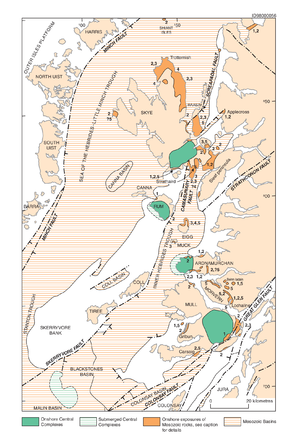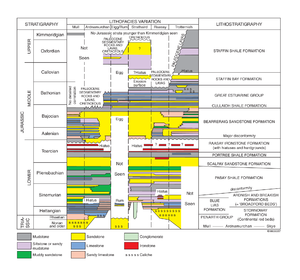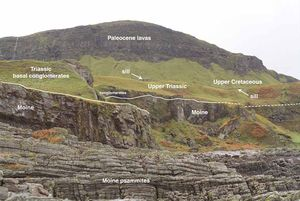Cretaceous, Palaeogene volcanic districts of Scotland
| Emeleus, C H, and Bell, B R. 2005. British regional geology: The Palaeogene volcanic districts of Scotland. Fourth edition. Keyworth, Nottingham: British Geological Survey. |
Introduction




Rocks ranging in age from the Triassic to the Late Cretaceous occur throughout the Inner Hebrides and on Arran (P914123). They are part of the extensive basinal deposits found mainly offshore, and in many instances represent the feather edges of these successions. The basins are important structural elements in the Hebridean Igneous Province. In addition to their dominant control on Mesozoic sedimentation, the basins and associated structures appear to have influenced the emplacement of the Paleocene central complexes and possibly also the accumulation of the lava successions.
Cretaceous
Cretaceous strata are present in isolated small outcrops, which generally owe their preservation to a protective covering of Paleocene lavas (Table 7). They were deposited unconformably over rocks varying in age from late Precambrian to Jurassic. It may therefore be inferred that a period of folding, uplift and erosion occurred between Late Jurassic and Early Cretaceous times in this district, as happened elsewhere in the north and west of the British Isles. These events produced a gently undulating surface with river valleys. This landscape was eventually submerged and low-energy shallow-water marine sediments were deposited. These consist of fine- to medium-grained sandstones, calcareous sandstones and limestones, and less commonly conglomerates and sedimentary breccias. There are marked differences in lithologies and in the successions from nearby areas, and on Eigg and on Mull there is clear evidence that some deposits have been reworked. Tectonic activity may have occurred throughout much of Late Cretaceous time. In Skye, some of the movement on the Camasunary Fault postdates the Cretaceous deposits, and on Mull, late movements on the Great Glen Fault probably affected the Cretaceous rocks at Torosay (Mortimore et al., 2001).
Thermal alteration of the Cretaceous rocks by the overlying Paleocene basaltic lavas makes precise dating of the deposits difficult, since microfossils and spores have commonly been destroyed. The Cenomanian age of glauconitic sandstones at the base of the successions in Mull and Morvern is firmly established (Lowden et al., 1992), but the age of overlying beds is less certain. At the top of the succession, the Beinn Iadain Mudstone Formation and part of the Clach Alasdair Conglomerate Member, may well be partly of Paleocene age (Mortimore et al., 2001), although Hancock (2000) suggested a Maastrichtian age for these beds on Mull, which he termed the Gribun Conglomerate Formation (see below). The brown mudstones have generally been interpreted as decomposed ash, deposited immediately prior to the main basaltic lava outpourings (e.g. Richey, 1961).
The presence of rounded ‘millet seed’ sand grains in many of the Hebridean Cretaceous rocks, together with the silica-cementation of some beds (interpreted as ‘silcretes’) and the presence of silicified chalk led to the suggestion that desert conditions prevailed around the chalk seas (Bailey, 1924), although others have disagreed with this interpretation. A study of the silicification within the Loch Aline White Sandstone Formation at the Lochaline Mine, Morvern showed that the silica-cementation, which has resulted in frosted and faceted sand grains of all sizes, is restricted to certain well-defined beds, suggesting that it was caused by groundwater circulation, concentrated along highly permeable layers (Lowden et al., 1992). The presence of lignite and lateritic mudstone overlying the chalk were taken by Mortimore et al. (2001) to suggest hot, wet conditions towards the end of Cretaceous time, which would have required a dramatic and sudden change in climate if this had been preceded by desert conditions.
The most complete successions of Upper Cretaceous rocks in the district are found at Gribun, Mull (over 15 m thick) (P532641), and on Ben Iadain, Morvern (over 21 m thick) (P914125) (Mortimore et al., 2001 and references therein). Offshore deposits of Cretaceous age are very limited (Fyfe et al., 1993).
Skye
Three small outcrops of distinctive limestone, sandstone and conglomerate occur immediately below the Paleocene lavas around Beinn Leacach on the Strathaird peninsula (e.g. Hudson, 1983). Two of these outcrops include up to 2 m of blue, sandy limestone containing fragments of the bivalves Inoceramus and Pecten. The limestone, together with the underlying coarse-grained calcareous pebbly and gritty sandstones (about 1 m thick), have been assigned to the Upper Cretaceous (Turonian) Strathaird Limestone Formation. The formation also crops out south of Strollamus, where a 3 m-thick bed of white limestone overlies Oxfordian strata. On the north side of Soay Sound, up to 16 m of red and green glauconitic sandstone, capped by hard sandstone with cherty concretions, have yielded microfossils of probable Cretaceous age, and have been assigned to the Cenomanian Morvern Greensand Formation. Chaotic assemblages of clasts and slabs of Cretaceous sandstone and chert are found hereabouts; they formed in pre-Paleocene times, when Cretaceous strata collapsed into a cavity formed by solution-weathering of the underlying Lower Jurassic limestones. Glauconitic sandstones recovered from landslips below the Paleocene lava cliffs of Waterstein Head in north-west Skye are also probably Cretaceous in age.
Scalpay and Raasay
A Cretaceous sequence, about 5 m thick, underlies basaltic lavas in the Allt Stapaig valley in the south of Scalpay, close to the Strollamus outcrops on Skye. The upper half of the succession consists of sandstone with a bed of chert nodules at the base. Underlying the sandstone is limestone with cherty masses and, at the base, about 0.5 m of hard calcareous gritty sandstone containing the bivalves Exogyra and Pecten asper. The lower beds may be equated with the Strathaird Limestone Formation. A thin bed of glauconitic sandstone on the western side of Dun Caan, Raasay is probably of Cenomanian age (Lee, 1920).
Eigg
At Laig Gorge, about 2.5 m of conglomerate fines upwards into coarse- and fine-grained sandstones, forming the Laig Gorge Sandstone Member. Rounded pebbles in the conglomerate include quartzite, vein-quartz and phosphorite (which may contain ooidal chamosite). Hudson (1960) has recorded a derived Oxfordian ammonite, Cardioceras (Scarburgiceras) from these beds. The overlying 2.5 m-thick beds consist of sandy limestones overlain by flint-free micritic limestones. The limestones contain a planktonic fauna including the foraminifera Hedbergella praehelvetica, which indicates an early to mid-Turonian age. Rare fragments of Inoceramus bivalves also occur. At Clach Alasdair, west of the Bay of Laig, glauconitic sandstones and silicified flint conglomerates form a layer less than 1 m thick between calcareous siltstones of the Staffin Shale Formation and overlying Paleocene lavas. These beds form the Clach Alasdair Conglomerate Member and, together with the Laig Gorge succession, they are assigned to the Strathaird Limestone Formation. Their Cretaceous age has been determined from a poorly preserved microfauna (Harker, 1908). In northern Eigg, exposures in the Allt Ceann a’ Gharaidh comprise about 50 cm of coarse conglomerate with pink to grey, possibly baked, flint fragments up to 10 cm in diameter, overlain by white sandstone containing rare glauconite; wedges of chalk conglomerate are present and lignite occurs towards the top of the section (Mortimore et al., 2001). These deposits overlie sandstone of the Valtos Sandstone Formation, and are capped by Paleocene lavas.
Ardnamurchan
No in-situ fossiliferous Cretaceous deposits have been described from this area but remanié flint pebbles, rounded quartz grains and a shark’s tooth (Oxyrhina (?)mantelli) have been found in mudstone beneath Paleocene lavas on the south-east side of Bheinn Buidhe in eastern Ardnamurchan (Richey and Thomas, 1930). A bed of highly indurated pure quartz sandstone, about 1 m thick, overlies Moine psammite and underlies red mudstone (possibly of the Beinn Iadain Mudstone Formation) and lavas, about 2 km east of Ben Hiant. This may be the equivalent of the indurated sandstone of Cretaceous age that is seen on the north side of Morvern
Mull
At Gribun, Cenomanian glauconitic sandstone (6 m thick) is overlain by 3 m of white sandstone and 3 m of silicified chalk with flints (possiby Santonian). The chalk is overlain by breccia containing angular pebbles and cobbles of silicified chalk, sandstone with chert nodules, and 2 m of weakly bedded, red mudstone. The beds above the chalk have been formally designated the Gribun Conglomerate Formation by Hancock (2000), but have been equated with the Clach Alasdair Conglomerate Member and Beinn Iadain Mudstone Formation by Mortimore et al. (2001). The succession is overlain by Paleocene lavas (P532641). A rich bivalve fauna is known from the glauconitic sandstone, including Rhynchonella, Exogyra conica, and Pecten asper. Ostrea and Pecten have been found in the chalk. Glauconitic sandstone occurs at Auchnacraig, south of Loch Don, and also at Carsaig where it reaches about 13 m, its greatest thickness in the district.
Morvern
Siliceous and glauconitic sandstones, characterised by species of Exogyra and Pecten bivalves, underlie the Paleocene lavas of Morvern. At the Lochaline mine there are excellent exposures of a white sandstone (about 15 m thick), formed from pure quartz sand that is generally poorly cemented, except in hard, silica-cemented bands (see above). The locality is an important source of high-grade glass-sand (p. 174). The thickest succession is on Beinn Iadain, where the sandstones are overlain sequentially by about 1 m of silicified chalk, the Clach Alasdair Conglomerate with intraclasts of silicified chalk, and clastic sedimentary rocks with lignite of the Beinn Iadain Mudstone Formation (P914124).
Arran
Rocks of Cretaceous age on Arran are restricted to chalk with flints and white sandstone contained in several remanié masses within the Central Arran Ring-complex. Microfossils and fragments of Inoceramus bivalves recovered from these rocks indicate a Late Cretaceous age (Tyrrell, 1928). Most of the limestone is thermally altered but some pieces are merely indurated and resemble the chalk of Antrim.